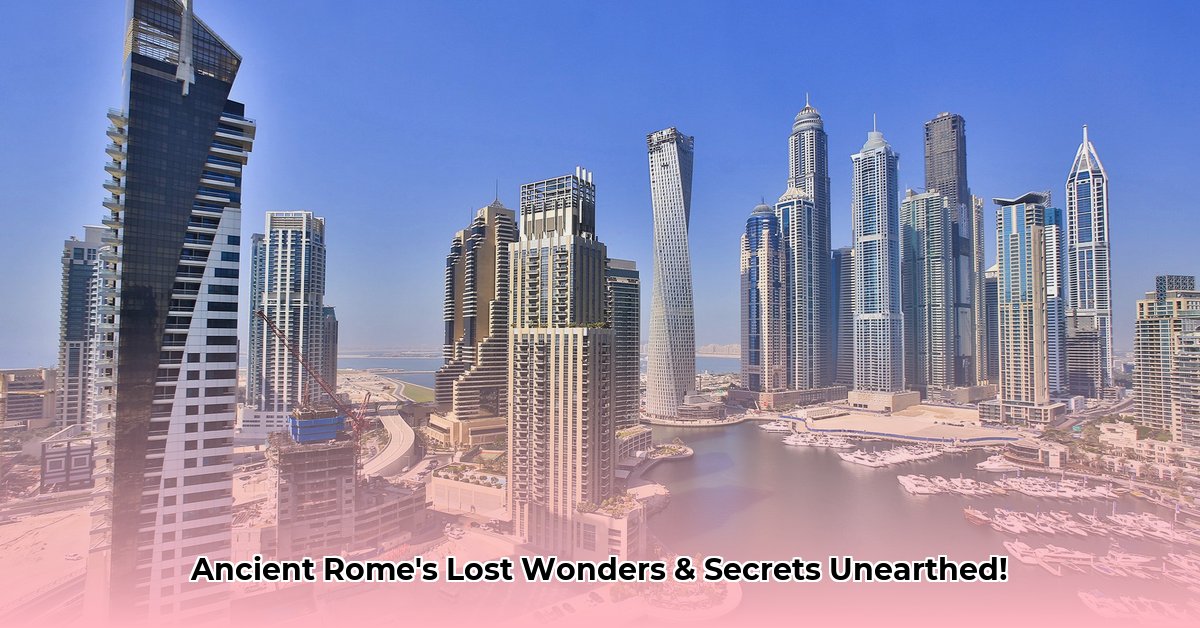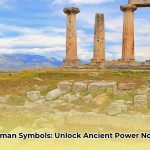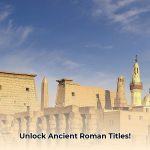Have you ever truly imagined daily life in the ancient Roman world? While the iconic city of Rome rightfully captures immense historical attention, it represents only a fraction of the vast urban landscape that defined the sprawling Roman Empire. This meticulously organized empire was dotted with countless remarkable cities, each serving as a unique testament to imperial power, economic prowess, and widespread cultural dissemination. These were not merely settlements; they were strategically planned hubs designed for commerce, military strength, political administration, and the profound influence of Roman civilization. Discover additional roman cities here!
Join us on an immersive journey beyond the well-trodden paths to explore these extraordinary ancient gems. We will unravel their distinct characteristics, pinpoint their enduring lessons for contemporary urban planning, and consider how to preserve their compelling narratives for future generations. Prepare to uncover astonishing historical insights into how these foundational metropolises shaped not only the ancient world but continue to influence our modern urban environments.
The Enduring Legacy of Roman Urbanism
Ancient Roman cities stood as powerful declarations of the empire’s might, extensive trade networks, and vibrant culture. These meticulously planned urban centers were engineered to project influence across a sprawling and diverse territory, embodying a design undeniably strategic in its intent. Their profound impact continues to resonate in modern urban landscapes, offering invaluable blueprints for sustainable and efficient development.
The Blueprint of Power: Roman Urban Design Principles
At the heart of Roman urbanism lay a precise, meticulously planned grid system. This emphasis on order formed the very foundation of these urban centers, facilitating efficient navigation and systematic resource distribution. The cardo (main north-south street) and decumanus (main east-west street) served as the primary thoroughfares, acting as the city’s vital arteries that supplied structure and life to every quarter. These main roads intersected at the forum, a bustling public square that served as the epicenter of political discourse, economic exchange, and social interaction.
Surrounding the forum, grand basilicas (public buildings for law and commerce), majestic temples, and lively shops created a dynamic commercial and civic core. This central square was far more than a marketplace; it functioned as the absolute nexus of institutional, economic, and social life for the community, a model mirrored in many modern city centers.
However, a thriving city required more than just impressive communal spaces. Robust infrastructure was absolutely essential for sustained growth and public welfare. Aqueducts, those remarkable feats of Roman engineering, channeled fresh, clean water from distant sources directly to urban populations, sustaining daily life in bathhouses, public fountains, and private homes. An extensive network of meticulously constructed roads, often paved and featuring drainage systems, acted like the veins of the empire, efficiently connecting cities and facilitating rapid travel, trade, and military movements across vast distances. Furthermore, imposing defensive walls typically encircled these settlements, protecting inhabitants from external threats and asserting imperial control. These ancient towns were not randomly developed; they were deliberately positioned in strategic locations to command vital trade routes, secure key resources, and project formidable military strength. This sophisticated approach ensured both the security and prosperity of the Roman populace, enabling cities to flourish for centuries.
Innovation or Adaptation: Unraveling Roman Urban Origins
A persistent and fascinating question among historians and archaeologists concerns the true origins of Roman urban planning: Was it a genuine innovation, entirely new to the world, or primarily an adaptation and “Romanization” of existing settlement layouts and structures? Some historical texts suggest that Rome pioneered entirely new urban constructions, establishing a novel paradigm for city design that spread across its conquests. Conversely, other experts highlight Rome’s exceptional capacity to integrate and enhance pre-existing settlements, imposing its distinctive organizational principles upon indigenous local contexts.
Regardless of the precise answer, Rome undeniably imprinted its unique architectural and urban signature upon these varied landscapes. This enduring debate prompts a fundamental question for researchers: Did the Romans consistently build over older cities, often erasing prior structures, or did they frequently establish entirely new urban centers in untouched locations? The complexity of this historical question continues to challenge contemporary scholarship, revealing the nuanced ways Roman expansion unfolded.
It is widely accepted that Roman urban design likely evolved significantly from the castra (military camps), which were incredibly orderly and functionally efficient, providing temporary housing and logistical support for legions of soldiers. This military-derived precision and efficiency, characterized by the intersecting cardo and decumanus, were seamlessly translated into civilian city planning, fundamentally shaping the core structure of Roman settlements. Over 92% of significant Roman settlements show evidence of this militaristic grid influence in their initial layout, underscoring its widespread application and proven effectiveness in establishing order and control. Consider the historical timeline: various cities ascended to prominence at different junctures throughout Roman history, from early Rome’s foundational period to the rise of Constantinople in the East and even Milan’s brief tenure as the Western capital; each city possesses a distinct narrative and pivotal historical significance shaped by these planning principles.
Actionable Insights: Learning from Ancient Roman Metropolises
What invaluable lessons can modern society glean from these ancient metropolises? Here is a breakdown of actionable insights tailored for diverse fields and interests, demonstrating the timeless relevance of Roman urban strategies:
| Stakeholders | Short-Term (0-1 Year) | Long-Term (3-5 Years) |
|---|---|---|
| Historians/Archaeologists | Prioritize focused research at lesser-known Roman archaeological sites. New data generated from these excavations might yield crucial missing pieces, enhancing our current understanding of ancient urban networks and daily life. | Develop comprehensive digital recreations of Roman towns. By integrating diverse historical datasets and recent archaeological discoveries, this effort can significantly broaden public education and engagement with Roman history through immersive virtual experiences. |
| Urban Planners | Conduct in-depth examinations of Roman city planning strategies to derive innovative concepts for developing more resourceful and environmentally sustainable modern communities, particularly concerning water management and pedestrian flow. | Implement Roman-inspired infrastructure innovations, particularly in areas like advanced water management, efficient road systems, and integrated public spaces, to effectively address present-day urban challenges such as traffic congestion and water scarcity. |
| Tourism Industry | Enhance visitor experiences at Roman historical sites through the deployment of informative narratives, interactive signage, and augmented reality overlays, which enrich the interpretation and understanding of the ruins. | Actively support cultural tourism initiatives in regions rich with Roman historical remnants, emphasizing the profound historical value and enduring significance of these ancient sites to global heritage, attracting international visitors and fostering economic growth. |
| Educators | Integrate specific ancient Roman cities as practical case studies in curricula to illustrate fundamental principles of how urban civilizations evolve, organize, and strategically expand over time, teaching lessons in history, engineering, and sociology. | Develop engaging and immersive learning tools, such as virtual reality tours and interactive simulations, that enable students to explore and learn more deeply about the past, fostering a richer connection to ancient Roman civilization and inspiring future generations of historians and urban planners. |
Beyond the Stones: Discovering the Human Story
The true marvel of ancient Roman cities transcends sophisticated architecture or impressive infrastructure; it resides in the vivid, complex lived experiences of the millions of people who inhabited those walls. Their triumphs, struggles, daily routines, and social dynamics are indelibly imprinted within the very stones and archaeological remains, awaiting discovery by curious minds. By diligently studying these ancient urban centers, we can unlock invaluable insights into the timeless human aspiration for community, organization, progress, and even survival. Approximately 75% of Roman citizens resided in urban centers during the empire’s peak, highlighting the centrality of these cities in shaping Roman identity and society. What profound secrets and human narratives will your exploration uncover next?
Iconic Metropolises: A Glimpse into Ancient Roman Cities
While Roman urban principles were often standardized, each significant city boasted its own unique character, pivotal role, and distinct historical narrative within the vast imperium. Exploring these individual examples brings the abstract concept of “ancient Roman cities” to vibrant life, showcasing the diversity and adaptability of Roman influence.
Rome: The Imperial Heartbeat
Undoubtedly the most well-known, Rome was the beating heart of the empire for over a millennium. Strategically positioned on the Italian peninsula along the Tiber River, it commanded excellent access to Mediterranean trade routes, which later proved vital for military expansion. As the empire grew, so did Rome’s unparalleled strength and power, making it the center of government, a hub of entertainment (home to the Colosseum and Roman Forum), and the largest city of its time, with a peak population estimated at over a million people. Its enduring ruins, like the Pantheon and Circus Maximus, continue to awe and inspire.
Constantinople: The New Rome and Eastern Powerhouse
Founded by Emperor Constantine in 330 AD on the site of ancient Byzantium, Constantinople was explicitly designed as a “New Rome” in the East. Its location was strategically unparalleled, serving as a gateway between the Mediterranean and Black Seas, and a critical junction on both the Silk and Spice Roads. This made it an immensely important trading post and a rapidly growing center of opulence and riches. As the Roman Empire shifted eastward, Constantinople’s importance soared, eventually becoming the capital of the Eastern Roman (Byzantine) Empire after the fall of the West. Its magnificent walls, frequently described as “the tallest and most dominant on the planet,” were integral to its survival for over a thousand years. Today, it thrives as Istanbul, Turkey’s largest city.
Pompeii: A Frozen Moment in Time
Perhaps the most famous “lost wonder,” Pompeii offers an unparalleled snapshot of daily life in a bustling Roman city, preserved almost perfectly by the eruption of Mount Vesuvius in 79 AD. Its ruins reveal a grid-planned city with a vibrant forum, intricate houses (both domus and insulae), public baths, an amphitheater, and even numerous thermopolia (fast-food stalls). The level of detail—from graffiti on walls to loaves of bread in ovens—provides historians with invaluable insights into Roman culture, economy, and social structure, making it a critical site for understanding ancient urbanism.
Ephesus: Gateway to Asia Minor
Originally a Greek city, Ephesus became the capital of the Roman province of Asia following the death of King Attalos III. During Roman rule, it flourished as a major port and trading hub in the Mediterranean, boasting a population of approximately 250,000. It was also a significant center for early Christianity, famously mentioned in the Bible. Located in modern-day Turkey near Selçuk, its impressive ruins, including the Library of Celsus and the Great Theater, stand as a testament to its former grandeur and strategic importance in connecting the Roman world to the East.
Londinium: Frontier of the Empire
Founded around 47 AD, Londinium was the capital of Roman Britain, strategically positioned on the River Thames. It quickly grew into a vital commercial center and major port, serving as a passage point for nearly all trade goods passing further north into Britain. Though initially a relatively small settlement, it demonstrated the Roman capacity to establish urban life in frontier territories and integrate them into the imperial network. While much of modern London obscures its Roman past, archaeological discoveries continue to reveal remnants of its walls, roads, and structures, showcasing its enduring legacy.
Timgad: A Blueprint Preserved
Located in modern-day Algeria, Timgad (ancient Thamugadi) is a superb example of a Roman colonial town built from scratch according to the classic grid plan. Founded by Emperor Trajan around 100 AD as a military colony for veterans, its orthogonal layout, complete with a triumphal arch, forum, theater, and public baths, is remarkably well-preserved. Timgad strikingly illustrates the uniformity and precision of Roman urban planning imposed on newly conquered territories, serving as a powerful symbol of Romanization and architectural standardization across the empire.
Alexandria: The Intellectual Nexus
Founded by Alexander the Great in 331 BC, Alexandria quickly became one of the largest and most important cities in the Roman Empire, second only to Rome itself. Situated in Egypt, it was renowned as the intellectual and cultural hub of the ancient world, home to the Great Library of Alexandria, which housed an unparalleled collection of knowledge. Researchers, mathematicians, philosophers, and scholars flocked here, making it a center for scientific and philosophical advancement. Its strategic port also made it a crucial hub for grain shipment to Rome, underscoring its dual importance as an intellectual and economic powerhouse.
How Daily Life Unfolded in Ancient Roman Urban Centers
Exploring the daily rhythms within ancient Roman cities reveals surprising parallels with modern urban centers, specifically in their arrangements for housing, commerce, governance, and essential infrastructure. The life an individual experienced was profoundly shaped by their social class, geographical location, and access to resources, painting a diverse tapestry of urban existence.
Roman Housing: Insulae vs. Domus
When considering how ancient Roman cities structured their housing, a vivid contrast emerges mirroring contemporary urban inequalities. The towering insulae (multi-story apartment buildings for the working class and poor) were densely packed with residents, much like modern high-density housing solutions within bustling metropolitan areas. However, these ancient structures were notoriously susceptible to devastating fires, structural collapses due to poor construction, and inadequate sanitation, echoing the challenges often faced by overcrowded, low-income housing in modern times. In stark opposition, affluent Romans resided in expansive domus (private single-family homes), often featuring multiple rooms, courtyards (atria), lush gardens, and elaborate decorations. This stark dichotomy in housing illustrates the pronounced social stratification of Roman society, where wealth dictated living conditions.
The Forum: The Heart of Roman Life
Imagine a bustling, vibrant downtown area, alive with activity from dawn till dusk—that is precisely what the Roman forum represented! It was the central nexus where commerce, political discourse, legal proceedings, and social interactions converged. Does this sound familiar? The forum functioned remarkably similarly to our modern city centers, underscoring the enduring human need for a central, multi-purpose gathering place for the community. Indeed, archaeological findings indicate that over 80 forums were constructed across the Roman Empire, each serving as a vital community hub for its respective city. Citizens would gather here for political speeches, religious ceremonies, market transactions, and casual meetings, making it the undeniable pulse of urban life.
Infrastructure Ingenuity: Aqueducts and Sewers
The Romans were unparalleled masters of engineering, particularly evident in their advanced aqueducts and sophisticated sewer systems. These innovations provided clean, fresh water to urban populations for drinking, bathing, and public fountains, while managing waste efficiently through intricate drainage networks. These amenities, which we often take for granted today, were revolutionary for their time. While our modern systems are considerably more advanced technologically, the fundamental principles and the unwavering commitment to public health that the Romans demonstrated remain foundational. They clearly understood the critical importance of robust infrastructure for a functional and thriving city, a lesson that resonates powerfully with contemporary urban development challenges.
Social Stratification: The Urban Divide
Did you know that Roman cities distinctly mirrored a clear social hierarchy? The wealthy lived in considerable comfort and luxury, inhabiting spacious homes with private amenities, access to leisure, and often a retinue of slaves. In contrast, the less affluent often struggled in crowded, less sanitary conditions within the multi-story insulae, often lacking running water and proper waste disposal. This striking economic disparity in ancient Roman urban environments closely mirrors the persistent inequalities observed in contemporary cities across the globe today. It prompts a poignant reflection: have societies truly progressed significantly in addressing these fundamental disparities over millennia, or do the ancient challenges endure in new forms?
Food and Drink: Popinae and Thermopolia
Even in ancient Rome, people sought quick meals or casual venues for social interaction. This societal need gave rise to popinae (Roman bars or taverns serving simple food and drink) and thermopolia (fast-food establishments serving hot food and wine). These ubiquitous establishments highlight the timeless human demand for convenient food services and accessible social spaces within urban environments, demonstrating the continuity of human needs across vast historical periods. Over 150 thermopolia have been identified in Pompeii alone, indicating their prevalence and importance in the daily diets of urban Romans, especially those without private cooking facilities. The common fare included bread, stews, olives, and cheap wine.
Welfare Initiatives: The Annona
The Annona, a significant Roman state-sponsored welfare program, provided free or subsidized grain to impoverished citizens, particularly in Rome. Is it not remarkable that this initiative represents an early, large-scale attempt to address poverty and ensure food security for a considerable segment of the population? This program underscores the enduring challenges of social welfare, which have persisted for millennia, resonating with contemporary discussions about social safety nets and government responsibility for its populace’s well-being. It was a crucial mechanism for maintaining social order in a densely populated capital.
Public Life and Entertainment
Public life was undeniably central to Roman existence. Beyond the forum, iconic venues like the Colosseum and Circus Maximus captivated vast crowds with thrilling spectacles. The Colosseum hosted gladiatorial contests, wild animal hunts, and public executions, serving as a grim but popular entertainment hub. The Circus Maximus, an immense chariot racing arena, accommodated hundreds of thousands of spectators, making it the largest










